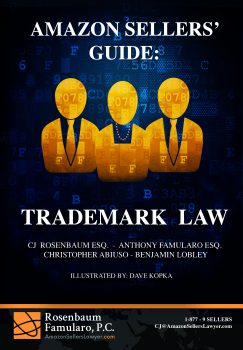
Amazon Sellers’ Guide: Trademark Law
By: CJ Rosenbaum Esq., Anthony Famularo Esq., Christopher Abiuso, and Benjamin Lobley
Chapter 4: Trade Dress ……….. 46
I. Introduction ……….. 46
II. Protectability ……….. 47
III. Trade Dress Categories ……….. 51
IV. Trade Dress Enforcement under the Lanham Act ……….. 54
CHAPTER 4: TRADE DRESS
I. Introduction
Trade dress is a form of intellectual property that is protected under the Lanham Act and has been defined by the Supreme Court as the “total image and overall appearance” of a good. Under the traditional view, trade dress only protected the way a product was “dressed up” and sold in the market. The modern standard of trade dress established by the Court finds features such as size, shape, color or color combinations, texture, graphics, and particular sales techniques protectible under the concept of trade dress.
Almost any distinctive component of a product or service can be protected by trade dress.
However, the principal categories of trade dress are:
 (1) product packaging;
(1) product packaging;
(2) product design;
(3) color;
(4) business exteriors and interiors; and,
(5) sounds and scents.
The process for evaluating a product’s trade dress differs based on whether the feature is inherently distinctive or not.
In order to prevail in a trade dress infringement action under the Lanham Act § 43(a), a Seller must prove: (1) that the feature is non-functional; (2) that it’s mark is distinctive; and (3) that a likelihood of confusion exists between the Seller’s product and the infringer’s product.
Enforcing trade dress in court begins with the Seller drafting an inclusive complaint that includes all important features and elements of their product that they want protected under trade dress. Other considerations include whether the trade dress is registered or unregistered, whether the product’s feature is being infringed or diluted, and what relief is available to the Seller.
II. Protectability
Section 43(a) of the Lanham Act protects both registered and unregistered trade dress. Protection under § 43(a) requires that the trade dress must be non-functional and distinctive.
A functional feature of a product is a feature which gives the customer an actual benefit, rather than just assurance that it is from a particular producer. This means that the feature is part of the product, not part of the branding.
When determining if the feature is functional or non-functional, courts evaluate whether the feature is essential to the use or purpose of the product or to the cost or quality of the good. For example, the spherical shape of a soccer ball is imperative for its use in playing soccer. However, the color or design on a soccer ball could amount to trade dress because these would be non-functional features. This is because the color or design on a soccer ball is not an essential feature to its purpose and could easily be changed without inhibiting its primary use.
Courts have ruled that functional product features are not protected under the Lanham Act. The purpose of the functionality doctrine is to prevent Sellers from developing monopolies by obtaining trademark protection for the functional feature of a product and effectively eliminating the possibility of competition.
The Ninth Circuit has recognized two factors for determining if features are functional:
 (1) the availability of alternative designs and
(1) the availability of alternative designs and
(2) whether the particular design comes from a simple or cheap manufacturing method.
CJ’s Tip: The important thing to keep in mind regarding functionality is whether you are trying to trademark the purpose of the product you are selling or simply as the design or aspect of the good that is not important to its use.
To establish non-functionality, one must prove that the feature of the product does not affect competition.
Functionality is defined by the following two concepts:
(1) the utilitarian functionality test and
(2) the aesthetic functionality test.
The utilitarian test focuses on whether the design or feature of the product gives the manufacturer a cost advantage for production, shipping, or other related expenses. The utilitarian functionality test, also known as the Inwood test, established that the Supreme Court deems a product feature to be functional if it is essential to the use or purpose of the trade or affects the cost or quality of the good.
For example, the design of an x-frame foldable chair has been ruled as functional because the product is designed that way only to be a more efficient chair, not so the consumer will recognize the company who produced it. Therefore, it fits the utilitarian functionality test because the design is essential for the purpose of the chair rather than to distinguish the product from competitors. In re Becton, Dickinson and Co. evaluated whether the design of a cap for blood collection tubes was functional and determined that the cost was not a factor because the design of the cap did not lower manufacturing costs.
If the design is not functional based on the Inwood test, it must still pass the test established in Qualitex Co. v. Jacobson Products Co., Inc. In Qualitex, the Supreme Court created the “aesthetic functionality” test by ruling a feature is functional where exclusive use of the feature would put competitors at a significant non-reputation-related disadvantage. The Supreme Court in TrafFix Devices, Inc. v. Mtktg. Displays, Inc. clarified that the aesthetic functionality test need not be considered where the challenged product is functional under the utilitarian functionality test. Once the functionality of the product’s feature has been evaluated, one must analyze the distinctiveness of the product’s feature based on the tests discussed in the previous chapter.
The aesthetic test addresses features that are solely ornamental but are essential to effective competition.
III. Trade Dress Categories
The most prevalent category of trade dress is product packaging. Packaging covered by trade dress can include labeling, wrappers, cartons, containers, unique shape, and more.
In Paddington Corp. v. Attiki Importers & Distributors, Inc., a Court examined the importance of product packaging and evaluated what will constitute trade dress. First, is the packaging inherently distinctive or not. If the packaging is inherently distinctive, the court will only need to look at the likelihood of confusion. If the packaging is not inherently distinctive, the court evaluates whether the packaging is the custom in the industry. For example, packaging cereal in a rectangular shaped box is such common practice amongst cereal companies that no one brand would be able to claim trade dress for the shape of the common cereal box. However, without the common industry practice, the shape of a box could be suggestive or arbitrary and therefore inherently distinctive.
The design of the product is another important feature protected by trade dress that includes the product’s configuration. Trade dress as product design is incapable of being inherently distinctive and the Seller must provide proof of “secondary meaning.” For example, the three stripes on Adidas sneakers constitute a product design protected by trade dress because it has acquired secondary meaning.
A color combination on the product may rise to the level of being protected by trade dress. In Qualitex, the Supreme Court established the standard that even a single color can be protected. For example, a specific color used in connection with fiberglass insulation products that has no functional purpose, does not decrease manufacturing costs, and is solely used to identify the source of the goods, is protectible by trade dress.
The exterior and interior elements of a business, such as restaurants or other commercial businesses, can be protected by trade dress. The standard for this category was set out in a case called Two Pesos, Inc. v. Taco Cabana, Inc. In the Two Pesos case, one restaurant claimed another restaurant infringed on its’ trade dress by closely copying the festive atmosphere and decorative designs. The Court ruled that restaurant layouts such as food preparation areas visible to customers, storage items visible to customers, the tiles on the wall, mirrors placement, and types of chairs can be protected by trade dress.
The final category of trade dress protects sounds and scents of a particular good. For example, the USPTO has given trademarks to the scent of yarn and to the NBC chime sound .
IV. Trade Dress Enforcement under the Lanham Act
The enforcement of trade dress is similar to the enforcement of trademarks. The Lanham Act protects against infringement of registered or unregistered trade dress and trade dress dilution. Registered trade dress infringement is covered by § 32 of the Lanham Act, while unregistered trade dress infringement is covered by § 43(a). However, most trade dress infringement actions involve cases where the product has not been registered for trade dress.
The basic test for determining whether unregistered trade dress infringement has occurred is whether there is a “likelihood of confusion.”
Under § 43(a) of the Lanham Act, the likelihood of confusion standard is if the infringing trademark or trade dress is likely to cause confusion, or to cause mistake, or to deceive as to the affiliation, connection, or association of such person with another person, or as to the origin, sponsorship, or approval of his or her goods, services, or commercial activities by another person.
The act does not expressly say whom the likelihood of confusion must apply to, but most federal jurisdictions have favored confusion for the general public rather than potential customers of a manufacturer or business. The factors for likelihood of confusion are the same as the previous chapter.
When drafting a lawsuit, the Seller must clearly express the specific features of the product that is covered by trade dress. This allows the court to assess the protectability of the trade dress and award narrowly-tailored relief. Therefore, sellers frequently define trade dress as the features being copied by the defendant.
Anthony’s Advice: When drafting your complaint, make sure you identify the proper number of elements to be covered by trade dress. It is very hard to change your definition of trade dress during future proceedings. If you fail to list all the elements of trade dress related to your product, you subject yourself to other competitors stealing the unlisted elements in the future. If too many elements are listed, the defendant will be able to avoid the injunction by only changing a few of the elements and not all of them.
Another important factor to consider when suing for trade dress infringement is the burden of proving non-functionality is on the plaintiff. Therefore, Sellers asserting a trade dress infringement complaint need to prove the features included in the complaint are non-functional. However, for trade dress that is registered, the trade dress is presumed to be non-functional and the defendant has the burden of proving functionality.
Trade dress dilution is addressed in § 43(c) of the Lanham Act, which covers blurring or tarnishing of a mark. If the trade dress is not registered, a Seller must prove in a dilution action that: (1) the claimed trade dress, taken as a whole, is not functional and is famous and (2) if the claimed trade dress includes a mark or marks registered on the principal register, the unregistered matter, taken as a whole, is well-known, separate, and apart from any fame of the registered marks.
The principal forms of relief and defenses to a trade dress claim are below:
Principal Relief for Trade Dress Claims:
1. Injunctive relief
2. Actual damages (may be enhanced up to three times the actual amount in certain circumstances)
3. An award of the infringer’s profits
4. Attorney’s fees
5. Destruction of infringing articles
6. Product recall
Principal Defenses for Trade Dress Claims:
1. Functionality Defense
2. Preemption of State law claims

For a free copy of one of our books, email us today: CJ@AmazonSellersLawyer.com
- https://amazonsellerslawyer.com/your-guide-to-amazon-suspensions/
- https://amazonsellerslawyer.com/amazon-sellers-guide-trademark-law/
- https://amazonsellerslawyer.com/amazon-sellers-guide-copyright-law/
- https://amazonsellerslawyer.com/amazon-sellers-guide-chinese-intellectual-property-law/
- https://amazonsellerslawyer.com/amazon-law-library/
- https://amazonsellerslawyer.com/your-guide-to-selling-fashion-on-amazon/
